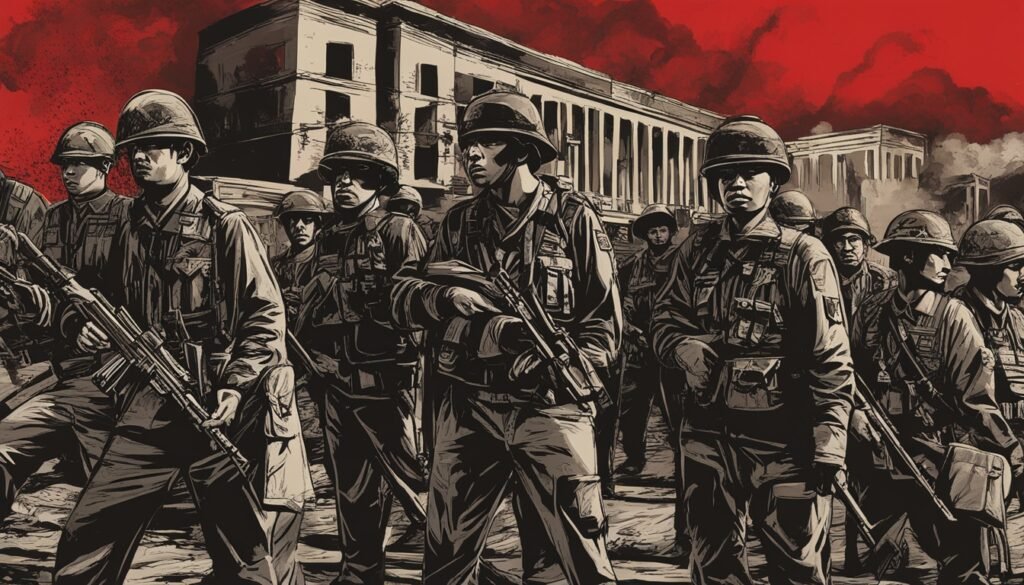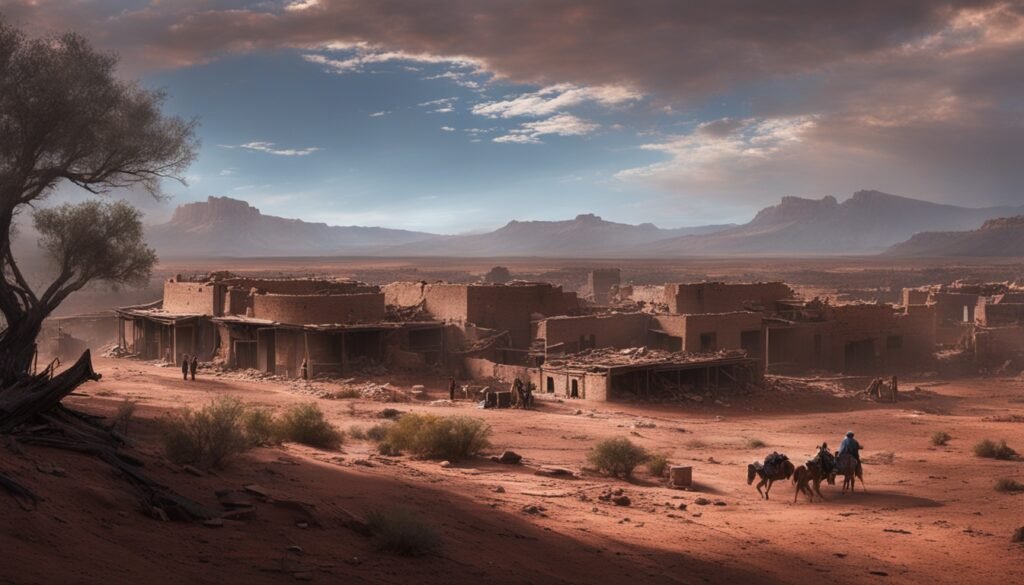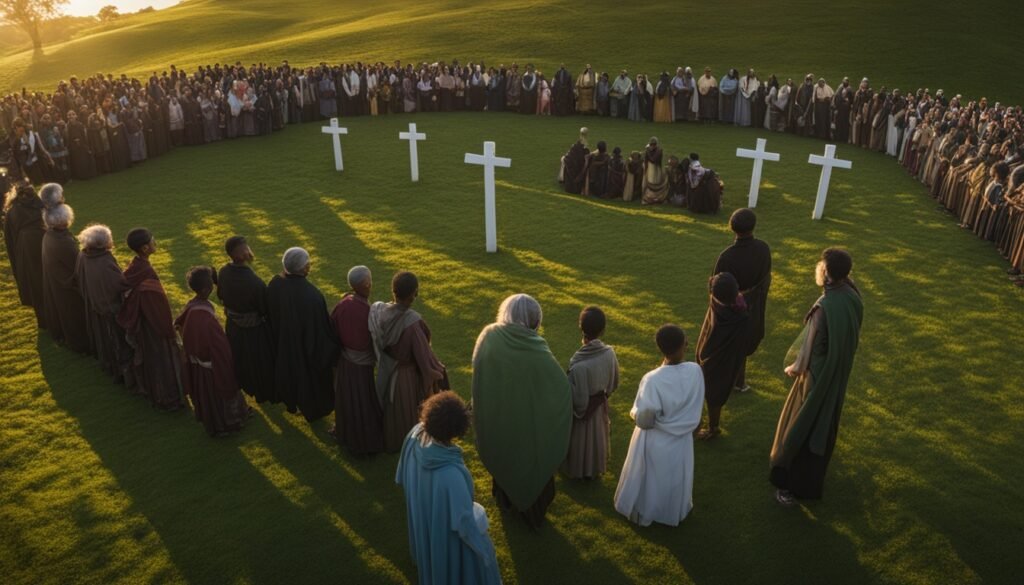In 1985, Negros Occidental, a province in the Philippines, saw a horrible event. It was called the Escalante Massacre. This happened during martial law and the deep control of the sugar industry. It left a big mark on Negros’ history.
Key Takeaways:
- The Escalante Massacre of 1985 was a significant event in the history of Negros Occidental, the Philippines.
- The massacre occurred during the martial law period, which was marked by oppressive rule and the suppression of opposition voices.
- The dominance of the sugar industry in Negros had profound social and economic implications for the region.
- The Escalante Massacre underscored the need for justice, accountability, and the protection of human rights.
- Remembering and learning from historical events like the Escalante Massacre is crucial for creating a just and peaceful society.
The Dark Prelude to the Massacre: Negros in the Shadow of Martial Law
During the Marcos regime’s martial law, Negros was under harsh rule and control. The region felt the oppressive effects of martial law, silencing opposition and people’s voices.
Imposing the Iron Fist: Negros Under Marcos’s Rule
Marcos’s authoritarian rule was strong in Negros. It left the people open to human rights abuses and stopped them from speaking out. The rich got richer in Negros, especially in the sugar industry, thanks to Marcos’s policies.
His tough ways made life hard for Negros’ people. This only made them want change more and resist against Marcos.
The Rise of Opposition: Sugar Workers and Activists’ Struggle
In Negros, a big movement against martial law started among a few groups. Sugar workers and activists were key in this resistance. They were tired of being treated badly and seeing the sugar industry get worse.
These people fought hard to make things better for themselves and their towns.
The image above shows how the people of Negros fought against these tough times and stayed strong.
The Eve of Bloodshed: Protests Intensify in Escalante
The days before the Escalante Massacre saw more and more people join protests. Tensions were high. The folks in Escalante came together to demand justice and change. They were united, fighting against those who oppressed them.
Teatro Obrero: The Voice of the Unheard on Stage
Amidst this tension, Teatro Obrero shone as a hope. This theater group spoke through plays. They showed the struggles of those who were often ignored, bringing them to life.
“The stage became a platform for the silenced voices, allowing the people of Escalante to express their frustrations, anger, and desires for a better future,” said renowned theater critic Maria Santos.
Teatro Obrero’s plays reflected the community’s experience. They highlighted neglected truths and inspired change. This energy and unity fueled the fight for justice.
Triggering a Tragedy: The 1985 Welgang Bayan
The 1985 Welgang Bayan marked a turning point. It was a peaceful strike. Yet, the response was not peaceful. The authorities used violence against their own people.
In Escalante, the Welgang Bayan events led to a violent clash. The confrontation turned into the Escalante Massacre. Law enforcement shot unarmed people, leading to a terrible loss of life.

This image shows how powerful and determined the protesters in Escalante were. It’s a powerful reminder of their courage during those dark times.
The protests in Escalante and Teatro Obrero’s efforts played key roles in history. They showed the world the struggles of the people. The Welgang Bayan showed the extremes the authorities would do to keep control.
The Story of Negros and the Escalante Massacre of 1985
In 1985, the Escalante Massacre shocked Negros, a province in the Philippines. Known for its sugar and rich history, it faced a tragic event. This marked the region and its people forever.
A peaceful demonstration in Escalante, Negros Occidental, turned tragic on October 20. People were voicing their issues against the harsh treatment of sugarcane workers and poor groups. Things quickly got out of hand and violence erupted.
The Escalante Massacre of 1985: a peaceful protest turned into a horrific tragedy.
Gunmen from a possible paramilitary group began shooting at everyone there. They didn’t care who they were hitting. Many innocent people, including men, women, and children, lost their lives.
The aftermath shook Negros and the whole Philippines. It highlighted the political and social troubles of the time. The sugar industry’s issues reflected larger problems in the nation.
The sugar industry was a huge part of Negros. While it brought wealth, it also brought deep divides. The wealthy few were on one side, with poor plantation workers on the other.
The Escalante Massacre exposed these deep social problems. It demanded change and justice. The call for labor reform echoed throughout the Philippines, beyond Negros.
The story of the Escalante Massacre in Negros is a key lesson. It shows the effects of inequality and the need for a fairer society. This story remains a symbol for standing up and fighting for justice in the Philippines.
A Day of Infamy: The Timeline of the Escalante Massacre
This section details the Escalante Massacre of 1985, day by day. It explains the events and the massive tragedy that took place.
It starts with the tensions and protests in Escalante, which were growing. We see how things got more violent, leading to many deaths.
After the massacre, the community and Negros history were greatly affected. This timeline shows the lasting sorrow of the Escalante Massacre, making sure it’s remembered.
Take a moment to reflect on the timeline of the Escalante Massacre:

| Date | Event |
|---|---|
| September 18, 1985 | Protesters gather in Escalante to demand fair wages and workers’ rights. |
| Afternoon | Tensions rise as the protest grows, leading to conflicts. |
| Evening | Gunshots cause chaos and fear among people. |
| Night | The violence worsens, and many protesters are killed. |
| September 19, 1985 | After the night, the tragedy’s full scope is revealed with many deaths. |
Reviewing the timeline shows how dark the Escalante Massacre was for Negros history. It’s a tragic memory that stays with the region.
Victims of Violence: Remembering Those Who Fell
This part is about remembering those affected by the Escalante Massacre. Their lives, although tragically short, had great impact. They left a deep mark on their families and those around them. By sharing their stories, we understand their dreams, hopes, and the great loss felt by all.
Young Lives Cut Short: Accounts of the Deceased
Those lost in the Escalante Massacre were mostly young. They were students, workers, and activists aiming for a better future. Unfortunately, their lives were ended early. This left their loved ones heartbroken and their communities in sorrow.
“My brother Jonathan was full of life and passionate about helping others. He dreamed of becoming a lawyer to advocate for justice and fairness in our society. He was taken from us too soon, but his memory will forever inspire us to continue the fight for the truth and justice.”
– Maria Dela Cruz, sibling of a victim
Each of the victims had their own unique story. Their ambitions and community work were sadly stopped by this violent act. Their memory remains, kept alive by those they left behind. These families and friends are dedicated to seeking justice and ensuring their stories are remembered.
Survivors’ Tales: The Enduring Scars of the Massacre
The survivors of the Escalante Massacre live with both physical and emotional scars. For them, that day changed their lives forever. The violence they saw and the trauma they experienced still affects them. Yet, their courage tells a story of strength and the human ability to overcome.
“I still remember the screams, the chaos, and the fear that enveloped the streets of Escalante. The images of that day continue to replay in my mind, and the nightmares persist. Despite the pain, I am determined to be a voice for the victims and a catalyst for change.”
– Carlos Martinez, survivor
The survivors stand strong despite the horrors they faced. Their bravery is a model for us all. Their experiences highlight the profound effects of violence and the ongoing need for justice and recovery.
An Ongoing Quest for Justice: The Aftermath of the Escalante Massacre
After the terrible events of the Escalante Massacre, the search for justice began. The families affected, along with rights groups, have been working hard. They want to see those responsible face justice for the horrible event.
Since the massacre, there has been a strong push for justice. People have been gathering proof, taking legal action, and letting others know. This is so everyone understands the awful things that happened and to make sure wrongdoers are punished.
But, getting justice is really tough. There are many roadblocks, like political issues and not enough resources. Yet, the victims’ families and their supporters have not given up.
The Escalante Massacre is a key moment in the fight for rights in the Philippines. It made a lot of people angry and got them to act against wrongs. This tragic event showed the nation must be fair and make sure those who do evil are punished.
Today, the memory of the Escalante Massacre lives on. The fight for justice continues strong. People are determined that the victims are not forgotten and that the guilty face their crimes.

The Social Fabric of Negros: Sugar Industry and Labor Struggles
The province of Negros is known for being the “Sugarbowl of the Philippines.” Its great soil and weather are perfect for growing sugar. The sugar industry has been key in shaping Negros’ society and economy. It has given jobs to many farmers and workers. Yet, the industry has faced tough times, which brought struggles to the people who work on the farms.
From ‘Sugarbowl’ to Sorrow: The Decline of Sugar Domination
For many years, the sugar industry was a big deal in Negros. It brought a lot of wealth to the area. The big farms, or haciendas, were owned by rich families. They used a lot of land and hired many people. But, things changed because of the global market, new farming ways, and laws about land.
The industry’s decline has hit the local economy hard. With low demand for sugar, many big farms had to close. This meant less work and money for those who worked on the land. Life became even more difficult for an area that relied so much on sugar.
Farmworkers’ Plight: Poverty and Human Rights Abuses
The situation for farmworkers in Negros has gotten worse because the sugar industry is not doing well. Many of them have unstable jobs, earn very little, and work in bad conditions. Poverty and unfairness are now very common, making it hard for workers to live.
There are also reports of abuse. Farmworkers have been through bad things like losing their land, being pushed out of their homes, and even facing violence. Their poor situation makes them easy targets for people wanting to take advantage of them.
Some groups and individuals are working to better the lives of these farmworkers. They are pushing for safer working conditions, teaching the workers about their rights, and asking for better pay. Their goal is to make things fair for everyone who works the land.
To sum up, the drop in sugar’s importance has greatly affected Negros and its people. The hardships faced by farmworkers, including poverty and mistreatment, show that we need to take action. People should work together to solve these serious problems and make the region a fairer place for all.
Culture and Remembrance: The Arts and Escalante
After the Escalante Massacre, art became a key way to honor and keep the memory of the tragedy alive. Theater, in particular, has been strong in telling the story and protesting. Teatro Obrero is a group that has really made a mark with their impactful performances.
Teatro Obrero, which means “The Workers’ Theater,” has been a voice in the fight for justice in Negros. They used their plays to bring the Escalante Massacre’s story to light, showing the pain and injustice faced by families. This theater group has been challenging wrongs and pushing for truth through their art.
“The power of theater as a form of protest lies in its ability to convey emotions, provoke critical thinking, and raise awareness. It allows us to explore the complexities of historical events and the human experiences connected to them,” says renowned playwright and director, Luisa Reyes.
Another important way the massacre’s memory is kept is through yearly re-enactments. These events remind people of the tragedy and help the community come together to honor those who died. They are also crucial in making sure younger people remember what happened.
These re-enactments are not just for remembering but also for calling for justice. They’re part of a continuing effort to hold responsible those who caused the violence.

The arts, like theater and these yearly events, help keep the memory of the massacre poignant in people’s minds. They are reminders of the ongoing fight for justice and human rights.
To deepen your understanding of this topic, read this insightful research paper.
Beyond Escalante: The Situation of Negros Post-Massacre
After the horrific Escalante Massacre, Negros was hit with many challenges. These challenges went far beyond the immediate effects. The massacre’s impact spread through the area, leaving wounds that needed time to heal. This part will look at the bigger picture of what happened in Negros after the massacre. It’ll show the hard times the community faced.
The Negros Famine: A Crisis Compounded
The Negros famine was a big issue after the massacre. It made life even harder for the people. Political and economic troubles, along with many deaths, made things very tough. This famine showed how hard the times were for the community after the massacre.
Lack of food and malnutrition were common during the famine. The crisis hit the agricultural sector hard, making food even scarcer. Add this to the grief and trauma from the massacre, and life was very difficult. The people of Negros urgently needed help to overcome these tough times.
Political Changes and Impact on the Community
The Escalante Massacre led to big political changes in Negros. People were angry and wanted those responsible to be held accountable. This event sparked a desire for better social and political actions.
After the massacre, the community worked together for justice. Grassroots organizations stood up for the oppressed and pushed for changes. These groups united the community to demand fairness and responsibility from their leaders.
The political shift in Negros gave the community strength and unity. This tragic event spurred a drive for a fair and inclusive society. It reminded people of the power of joining together in civic duties.
The effects of the Escalante Massacre and its aftermath still matter a lot. Despite the tough times, Negros’ people showed resilience and a goal for a brighter future. They continue their journey, hoping for healing and growth.
For more information, visit the South China Morning Post for an in-depth analysis on how this epic duo has transformed.
The Historical Significance of the Escalante Massacre
In 1985, the Escalante Massacre changed Negros and the Philippines. This event shook the society, elevating human rights, the labor faction, and the fight for fairness and democracy.
It spotlighted human rights problems in the country, showing how peaceful protests faced brutal responses. This brutal act drew eyes worldwide to the Filipino’s struggle under martial law. It urged a global effort to defend human rights and bring justice to those at fault.
The massacre was key for Negros’ labor force. It uncovered the hard situation of sugar workers and the industry’s systematic abuses. After the tragedy, workers united, striving for their rights. This bold move gave birth to a campaign for fair treatment and better work environments.
Moreover, the Escalante Massacre became a fight against dictatorial governance. It united activists and citizens alike, pushing for responsibility, fairness, and real change. Nationwide grief led to demands for a better, more democratic future.
The impact of the Escalante Massacre lives on in Negros’ history. It’s a beacon of the struggle for rights and dreams. This event shows Filipinos’ strength and their forever stand for what’s just and dignified.

Remembering the Escalante Massacre
Uncovering Truths: Insights from Historical Archives
This part looks at what we’ve learned from digging into historical archives. It helps us see the truth about the Escalante Massacre. By studying old records closely, we can find out more about what really happened, why it happened, and what followed.
From this deep study, we have learned a lot. It helps us better understand a very sad part of Negros’ past.
Academic Scrutiny: Research Findings on the Massacre
Many have worked hard to learn more about the Escalante Massacre. They have looked at old papers, stories, and official notes. Their work has shown us details about the events before the tragedy, what happened during, and what came after. They helped us see the social problems and struggles that led to the violence.
This research points to big issues in Negros Occidental, like poor and rich divides and worker mistreatment. It tells us about the tough times that made the tragedy likely. This is important for knowing the full story and the tragedy’s real impact.
Voice of the Media: How the Massacre was Reported
The press played a huge part in spreading news about the Escalante Massacre. It made sure people all over heard about it. This news made many Filipinos upset and wanting answers about what happened. It also made them think about justice and human rights in the country.
Reporting the events was not easy for the media back then. But, they were brave and did it anyway. Their stories helped people know what really went down. This led to talks across the country and calls for justice.
The things we’ve found in old archives, from studying records, and the media’s work all help. They add to our knowledge of the Escalante Massacre. They make sure we remember and keep looking for justice.
Learn more about the historical context of Negros Occidental
The Landscape of Healing: Efforts towards Reconciliation and Progress
Negros suffered greatly after the Escalante Massacre, both physically and emotionally. However, a firm resolve to heal, reconcile, and progress emerged. People, groups, and the local government came together to address the trauma and foster unity.
Healing has been a major focus since the massacre. Many initiatives offer support, counseling, and therapy. These aim to acknowledge the pain and provide safe spaces for survivors to heal together. Centers and groups help individuals manage trauma and start anew.
Reconciliation has been key in uniting the community. Through dialogues and peace efforts, understanding, forgiveness, and unity are cultivated. These steps aim to close gaps, build empathy, and unite despite tragedy-born divisions.
Acknowledging the past has been crucial in the healing journey. Truth and reconciliation processes have let the community face its history and learn from the past. This truth has laid a strong foundation for healing and progress.
Progress in Negros is fueled by a shared vision for a better future. Development projects in economy, education, and infrastructure are underway. They seek to improve living standards and open new opportunities for the people of Negros.

The healing, reconciliation, and progress in Negros are crucial to not forget the tragedy but to move forward positively. By addressing the past, promoting understanding, and aiming for a better tomorrow, Negros undergoes a process of profound healing and change.
For more information on the initiatives towards healing, reconciliation, and progress in Negros, you can visit this source.
Conclusion
The Escalante Massacre’s impact on Negros shows us why remembering history is crucial. This tragic event in 1985 shines a light on the fight for justice and human rights in the Philippines. It’s a significant part of Negros’ story.
Looking back at the Escalante Massacre helps us see Negros’ past clearly. It was a time of martial law and the strong grip of the sugar industry. The brave actions of sugar workers and activists stood against this, shaping the region’s history.
Remembering the victims of the massacre is key. They were fighting for their rights and a better future when they lost their lives. We must honor them and keep their memory alive as we strive for a fair and peaceful world.
Discussing the Escalante Massacre is important. By ensuring justice and remembering the sacrifices, we can prevent future similar events. Let’s use this memory to push for respect for human rights and work for a positive change, forever uplifting the importance of justice and rights in our minds.
To learn more about the Escalante Massacre, visit the Escalante Massacre Wikipedia page.
FAQ
What is the Escalante Massacre of 1985?
In 1985, a terrible event shocked the town of Escalante in the Philippines. On September 20, security forces fired upon a peaceful protest. This action resulted in the tragic deaths of several people.
What led to the Escalante Massacre?
The massacre was sparked by the 1985 Welgang Bayan, a national strike. The situation worsened between the sugar workers and security forces. The workers were protesting the harsh conditions of their work in the sugar industry in Negros.
How many people were affected by the Escalante Massacre?
The exact death toll from the massacre is still debated. At least 20 people were killed, and many more hurt during the violence. The tragedy deeply affected the community and the victims’ families.
What was the aftermath of the Escalante Massacre?
The massacre changed Negros and drew attention to human rights issues. It stirred outrage and awareness of abuses during martial law. Families and groups continue to push for justice for the victims.
Was there any justice served for the Escalante Massacre?
Efforts to find justice for the Escalante Massacre victims have gone on for years. Some wrongdoers were brought to justice, but many feel there’s more to be done. The fight to hold all responsible continues.
How did the Escalante Massacre impact Negros and its history?
The massacre left a significant mark on Negros and its history. It highlighted the hardships of sugar industry workers and the martial law’s brutality. The event symbolized resistance and inspired change in the area.
How is the Escalante Massacre remembered today?
Today, the Escalante Massacre is remembered through local re-enactments and cultural events. These events honor the need for justice and the community’s strength to overcome.
What lessons can we learn from the Escalante Massacre?
The massacre underscores the duty to protect human rights and oppose oppression. It shows the challenges still faced by many. It also stresses the importance of coming together to face injustice.
Source Links
- https://www.tumblr.com/the-martial-law-thingy/149260996448/the-escalante-massacre-was-an-incident-on
- https://www.cambridge.org/core/journals/theatre-research-international/article/sugar-overflows-and-teatro-obreros-escalante-story/1CB54FD49251BAA0B2F19DC8A91E91C8
- https://en.wikipedia.org/wiki/Negros_Occidental

